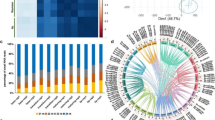Abstract
Non-coding RNA (ncRNA) plays an important role in regulating biological activities of animals and plants, and the representative ones are microRNA (miRNA) and long non-coding RNA (lncRNA). Recent research has found that predicting the interaction between miRNA and lncRNA is the primary task for elucidating their functional mechanisms. Due to the small scale of data, a large amount of noise, and the limitations of human factors, the prediction accuracy and reliability of traditional feature-based classification methods are often affected. Besides, the structure of plant ncRNA is complex. This paper proposes an ensemble deep-learning model based on convolutional neural network (CNN) and independently recurrent neural network (IndRNN) for predicting the interaction between miRNA and lncRNA of plants, namely, CIRNN. The model uses CNN to explore the functional features of gene sequences automatically, leverages IndRNN to obtain the representation of sequence features, and learns the dependencies among sequences; thus, it overcomes the inaccuracy caused by human factors in traditional feature engineering. The experiment results show that the proposed model is superior to shallow machine-learning and existing deep-learning models when dealing with large-scale data, especially for the long sequence.






Similar content being viewed by others
References
Costa FF (2010) Non-coding RNAs: meet thy masters. BioEssays 32(7):599–608
Heo JB, Lee YS, Sung S (2013) Epigenetic regulation by long noncoding RNAs in plants. Chromosome Res 21(6–7):685–693
Liu YH, Diao HY, Yao YL et al (2016) Long noncoding RNA NEAT1 promotes glioma pathogenesis by regulating miR-449b-5p/c-Met axis. Tumor Biol 37(1):673–683
Ma R, Wang C, Wang J et al (2016) miRNA–mRNA Interaction Network in Non-small Cell Lung Cancer. Interdiscip Sci Comput Life Sci 8(3):209–219
Huang ZA, Huang YA, You ZH et al (2018) Novel link prediction for large-scale miRNA-lncRNA interaction network in a bipartite graph. BMC Med Genomics 11(6):113
Paraskevopoulou MD, Hatzigeorgiou AG (2016) Analyzing miRNA-lncRNA interactions. Methods Mol Biol 1402:271–286
Jalali S, Bhartiya D, Lalwani MK et al (2013) Systematic transcriptome wide analysis of lncRNA miRNA interactions. PLoS ONE 8(2):e53823
Thomson DW, Dinger ME (2016) Endogenous microRNA sponges: evidence and controversy. Nat Rev Genet 17(5):272–283
Valiollahi E, Farsi M, Kakhki AM (2014) Sly-miR166 and Sly-miR319 are components of the cold stress response in Solanum lycopersicum. Plant Biotechnol Rep 8(4):349–356
Chen J, Peng H, Han G et al (2018) HOGMMNC: a higher order graph matching with multiple network constraints model for gene–drug regulatory modules identification. Bioinformatics 35(4):602–610
Gu JX, Wang ZH, Kuen J (2018) Recent Advances in Convolutional Neural Networks. Pattern Recogn 77:354–377
Li S, Li W, Cook C, et al (2018) Independently recurrent neural network (IndRNN): building a longer and deeper RNN. In: IEEE conference on computer vision and pattern recognition. https://arxiv.org/abs/1803.04831
Yi X, Zhang Z, Ling Y et al (2015) PNRD: a plant non-coding RNA database. Nucleic Acids Res 43(D1):D982–D989
Andreu PG, Antonio HP, Irantzu Anzar ML et al (2016) GREENC: a Wiki-based database of plant lncRNAs. Nucleic Acids Res 44(D1):D1161–D1166
Dai X, Zhao PX (2011) psRNATarget: a plant small RNA target analysis server. Nucleic Acids Res 39(suppl):W155–W159
Needleman SB, Wunsch CD (1970) A general method applicable to the search for similarities in the amino acid sequence of two proteins. J Mol Biol 48(3):443–453
Hinton GE, Osindero S, Teh YW (2006) A fast learning algorithm for deep belief nets. Neural Comput 18(7):1527–1554
Douzas G, Bacao F (2019) Geometric SMOTE a geometrically enhanced drop-in replacement for SMOTE. Inf Sci 501:118–135
Li C, Bovik AC, Wu X (2011) Blind image quality assessment using a general regression neural network. IEEE Trans Neural Networks 22(5):793–799
Krizhevsky A, Sutskever I, Hinton GE (2017) Imagenet classification with deep convolutional neural networks. Adv Neural Inf Process Syst 60(6):84–90
Wang L, Yang J, Liu H et al (2016) Research on a self-adaption algorithm of recurrent neural network based chinese language model. Fire Control Command Control 41(5):31–34
Alipanahi B, Delong A, Weirauch MT et al (2015) Predicting the sequence specificities of DNA- and RNA-binding proteins by deep learning. Nat Biotechnol 33(8):831–838
Jin KH, Mccann MT, Froustey E et al (2017) Deep convolutional neural network for inverse problems in imaging. IEEE Trans Image Process 26(9):4509–4522
Campos Victor, Sastre F, Yagues Maurici et al (2017) Distributed training strategies for a computer vision deep learning algorithm on a distributed GPU cluster. Procedia Comput Sci 108:315–324
Shi H, Xu M, Li R (2018) Deep learning for household load forecasting-a novel pooling deep RNN. IEEE Trans Smart Grid 9(5):5271–5280
Zhou C, You W, Ding X (2010) Genetic algorithm and its implementation of automatic generation of Chinese songci. J Softw 21(3):427–437
Yarotsky D (2017) Error bounds for approximations with deep Relu networks. Neural Netw 94:103–114
An FP (2018) Human action recognition algorithm based on adaptive initialization of deep learning model parameters and support vector machine. IEEE Access 6:59405–59421
Manaswi, Kumar N (2018) Deep learning with applications using Python || understanding and working with Keras. https://link.springer.com/chapter/10.1007/978-1-4842-3516-4_2
Liu T, Yin S (2017) An improved particle swarm optimization algorithm used for BP neural network and multimedia course-ware evaluation. Multimed Tools Appl 76(9):11961–11974
Cherkassky V, Ma Y (2004) Practical selection of SVM parameters and noise estimation for SVM regression. Neural Netw 17(1):113–126
Hung H, Jou ZY, Huang SY (2017) Robust mislabel logistic regression without modeling mislabel probabilities. Biometrics 74(1):145–154
Lu X, Wang P, Niyato D (2014) Wireless Networks with RF Energy Harvesting: a Contemporary Survey. IEEE Commun Surv Tutor 17(2):757–789
Xu A, Chen J, Peng H et al (2019) Simultaneous interrogation of cancer omics to identify subtypes with significant clinical differences. Front Genet 10:236
Lorenz R, Bernhart SH, Honer Christian, zu Siederdissen CH et al (2011) ViennaRNA package 2.0. Algorithms Mol Biol 6(1):26
Acknowledgements
This work was supported by the National Natural Science Foundation of China (Nos. 61872055 and 31872116).This paper was recommended by CBC2019.
Author information
Authors and Affiliations
Corresponding author
Rights and permissions
About this article
Cite this article
Zhang, P., Meng, J., Luan, Y. et al. Plant miRNA–lncRNA Interaction Prediction with the Ensemble of CNN and IndRNN. Interdiscip Sci Comput Life Sci 12, 82–89 (2020). https://doi.org/10.1007/s12539-019-00351-w
Received:
Revised:
Accepted:
Published:
Issue Date:
DOI: https://doi.org/10.1007/s12539-019-00351-w




